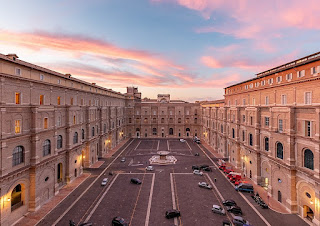Father of High Renaissance style left outstanding legacy
The architect and painter Donato Bramante, credited with introducing High Renaissance architecture to Rome, died on this day in 1514 in Rome, probably aged around 70.
Bramante made his mark in
Rome in the 16th century
Bramante, who was also a perspectivist painter, worked in Milan before moving to Rome, where he produced the original designs for St Peter’s Basilica and built several buildings and structures considered to be masterpieces of early 16th century architecture.
These include the Tempietto di San Pietro in Montorio on the summit of the Janiculum Hill, the Chiostro di Santa Maria della Pace near Piazza Navona, the Cortile del Belvedere and Scala del Bramante in the Vatican and the Palazzo della Cancelleria, located between Campo de' Fiori and Corso Vittorio Emanuele II.
Bramante was born Donato di Pascuccio d'Antonio in around 1444 to a well-to-do farming family in Fermignano, a town in what is now the Marche region, a few kilometres south of Urbino. He was also known as Bramante Lazzari.
Little is known of his early life, although it is possible he worked on the construction site of Federico da Montefeltro's Palazzo Ducale in Urbino, having trained under its architect, Luciano Laurana.
He moved to Milan in 1476 and the first work definitively attributed to him was in Bergamo, 50km (31 miles) or so to the northeast, where he painted murals, notably on the facade of the Palazzo del Podestà in 1477. His mastery of perspective is thought to have been influenced by Piero della Francesca, his contemporary.
In Milan, Ludovico Sforza appointed Bramante his court architect on the recommendation of his brother, Cardinal Ascanio Sforza. His work there included the a rectory and cloisters of the Basilica of Sant'Ambrogio, which featured his characteristic use of arches, and alterations to the church of Santa Maria Delle Grazie - famously the home of Leonardo da Vinci’s fresco The Last Supper - where he added a cloister, a rectory and a dome surrounded by columns.
.jpg) |
| Bramante's original design for the dome of St Peter's Basilica |
There, he immersed himself in the study of the architecture of ancient Rome, which would influence the style that became known as High Renaissance.
He became known to Giuliano della Rovere, the Cardinal who was the future Pope Julius II, his biggest patron. It was Julius who commissioned Bramante to build a new St Peter's, replacing the basilica erected by Constantine in the fourth century, which he envisaged would be the greatest Christian church ever constructed.
There was a competition organised, which Bramante won with a design based on an enormous Greek-cross structure topped by a central dome inspired by that of the huge circular Roman temple, the Pantheon. However when Pope Julius died in 1513, his successor replaced Bramante with Giuliano da Sangallo and Fra Giocondo, and the commission then passed to Raphael in 1514, a few months after Bramante’s own death. It was not until 1547 that Michelangelo took over as chief architect, making substantial changes to Bramante's original plan.
St Peter’s Basilica apart, Julius II employed Bramante on many more projects, including whole complexes of buildings, fountains and street layouts as the pontiff set about a programme of urban regeneration.
Among these, his Cortile del Belvedere - Belvedere Courtyard - a long, rectangular courtyard connecting the Vatican Palace with the Villa Belvedere in a series of terraces, linked by stairs, influenced the design of courtyards across Europe.
 |
| The Tempietto di San Pietro is considered a Bramante masterpiece |
Two of Bramante’s most acclaimed masterpieces, those that earned him the description of Father of the High Renaissance, were the cloister at Santa Maria della Pace, commissioned by Cardinal Oliviero Carafa around 1500, with a magnificent upper gallery characterised by alternating Corinthian pilasters and columns, and the Tempietto di San Pietro, commissioned by Ferdinand and Isabella of Spain, a circular temple composed of slender Tuscan columns, modelled after the ancient Roman Theatre of Marcellus.
An extrovert character who wrote poetry and music, Bramante was a close friend of Raphael, in whose fresco The School of Athens he depicts Bramante as the mathematician, Euclid.
Travel tip:
The town of Fermignano can be found
a few kilometres south of Urbino
Fermignano, Bramante’s birthplace, has a history that dates back to Roman times, when it was the location for the defeat of Hannibal’s Carthaginian army, led by his brother, Hasdrubal, in 207BC. Significant buildings include the Delle Milizie tower and a Roman bridge over the Metauro river. A former paper mill located in Via Santa Veneranda used to be rented out by the Montefeltro family. The church of San Giacomo in Compostela is an important historical monument with 14th and 15th century frescoes. A contemporary art gallery in the town is named after Bramante.
Travel tip:
The rectangular Cortile del Belvedere, designed by
Bramante, can be found in the Vatican City
The Vatican City, which contains some of Bramante’s most significant work, occupies an area of 44 hectares (110 acres) within the city of Rome and has approximately 1,000 citizens. Since 1929, it has enjoyed the status of the smallest sovereign state in the world by both area and population. It came into existence when an agreement was signed between the Kingdom of Italy and the Holy See to recognise the Vatican as an independent state. The treaty - known as the Lateran Treaty - settled what had been a long-running dispute regarding the power of the Popes as rulers of civil territory within a united Italy. The treaty was named after the Lateran Palace where the agreement was signed and although the signatory for the Italian government was the Fascist dictator Benito Mussolini, succeeding democratic governments have all upheld the treaty.
Also on this day:
1890: The birth of dictator’s wife Rachele Mussolini
1987: The death of writer and Auschwitz survivor Primo Levi
No comments:
Post a Comment